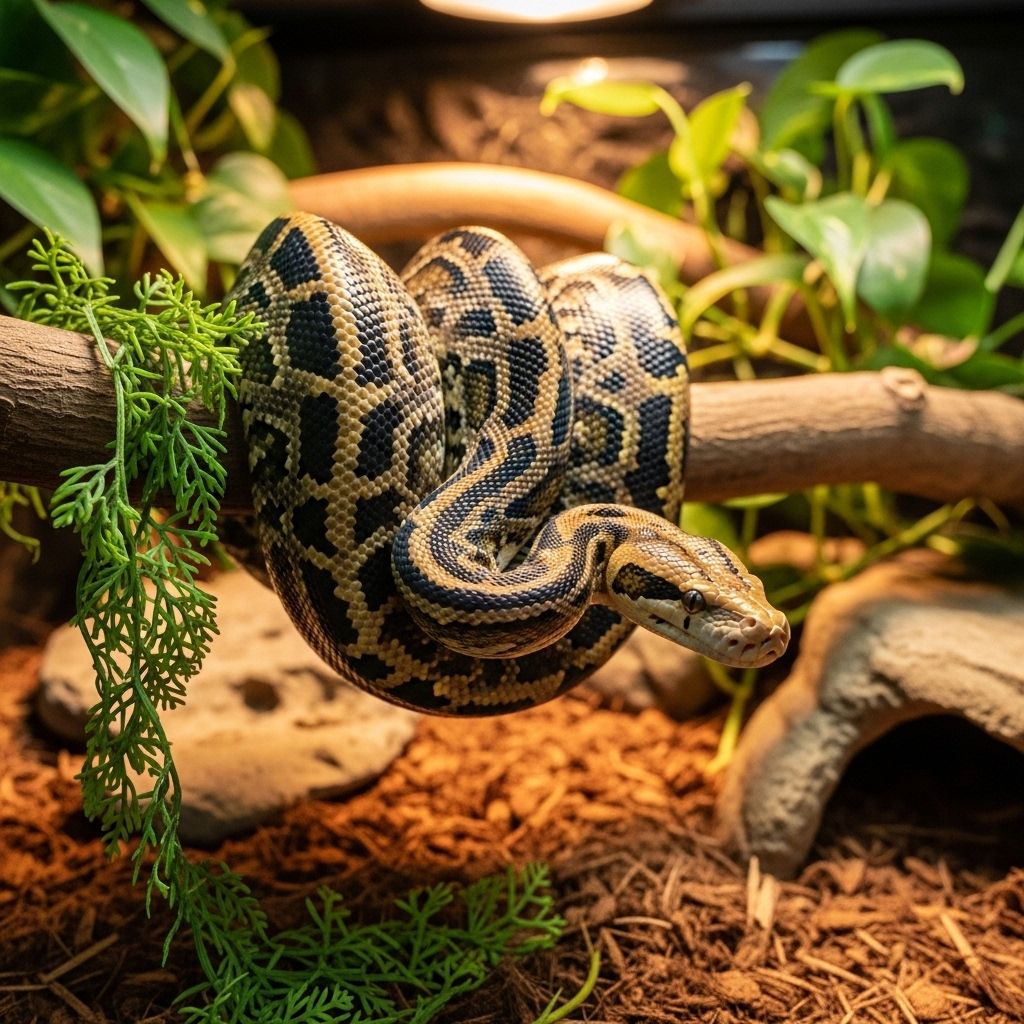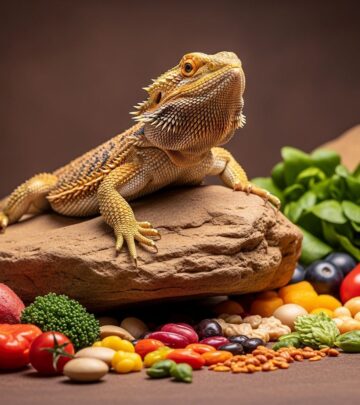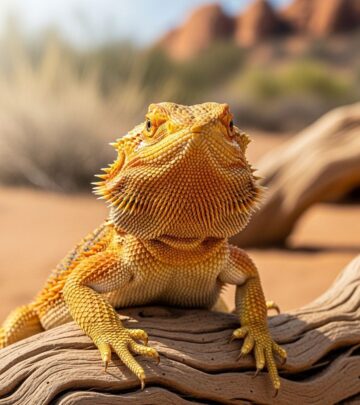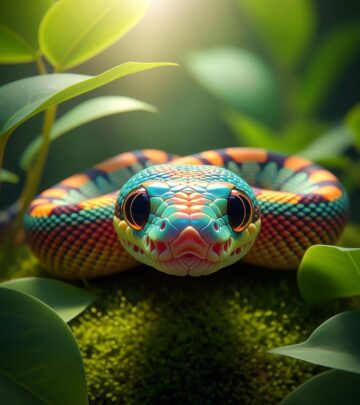Burmese Pythons as Pets: A Comprehensive Ownership Guide
Housing, feeding, and handling insights empower giant snake enthusiasts with confidence.

Burmese pythons (Python bivittatus) are among the world’s largest and most impressive snakes, captivating reptile enthusiasts with their size, strength, and distinctive beauty. However, their impressive stature is paired with specialized husbandry requirements and significant responsibilities. This guide delivers a deep dive into Burmese python care, ownership challenges, appropriate habitats, feeding, handling, health, and safety, fostering informed, responsible, and safe interactions with these gentle giants for dedicated keepers.
Overview of the Burmese Python
Burmese pythons originate from Southeast Asia, where they inhabit grasslands, marshes, forests, and areas near water. Recognized for their considerable size, docile demeanor in captivity, and striking coloration, Burmese pythons attract seasoned reptile keepers searching for a rewarding but challenging giant snake.
- Scientific name: Python bivittatus
- Average adult size: 12-18 feet (3.7–5.5 meters), some exceeding 20 feet
- Weight: Some adults can top 100-200 pounds
- Lifespan: 20–25+ years in captivity
- Natural habitat: Wetlands, swamps, grasslands, rainforests
These snakes are semi-aquatic and are excellent swimmers, often spending significant time in or around water sources. Due to their large adult size, Burmese pythons require specialized care and ample space, making them unsuitable for beginner or intermediate herpetologists.
Considerations Before Acquiring a Burmese Python
Before bringing a Burmese python home, it’s crucial to reflect on the serious commitment involved. These snakes may seem appealing as hatchlings, but their rapid growth and eventual size present logistical, safety, and ethical considerations.
- Long lifespan: Burmese pythons can live 20–30 years, requiring multi-decade care commitment.
- Significant size: Adult pythons can reach over 15 feet and weigh as much as an adult human.
- Enclosure space: Housing requirements expand considerably as pythons grow, ultimately necessitating room-sized enclosures for large adults.
- Feeding needs: These carnivores consume large prey, with mature individuals eating rabbits or similarly sized animals.
- Handling and safety: Large pythons pose physical risks. Multiple adults are recommended for handling or cleaning activities.
- Legal regulations: Burmese pythons are heavily regulated or banned in some areas due to their invasive potential and safety concerns. Always verify local laws before acquiring one.
Owners should reflect on their physical means, living situation (presence of children or pets), budget, and available support before pursuing Burmese python ownership. Alternative large snakes, such as boa constrictors or ball pythons, are often more feasible options for most enthusiasts.
Housing and Enclosure Requirements
Burmese pythons thrive in enclosures that mimic their natural environments, providing ample space, proper temperature gradients, humidity, and opportunities for both land and water activity.
Minimum Enclosure Dimensions
- Juveniles (under 8 feet): Minimum 8’L x 4’W x 4’H enclosure
- Adult females: Minimum 6′ x 3′ (72″ x 36″) and up to 8′ x 4′ (96″ x 48″) for extra-large adults
As Burmese pythons grow, their enclosures should scale proportionally. Many owners opt for custom enclosures or dedicate entire rooms for adults. Secure, escape-proof doors (sliding or hinged with reliable locks) are essential, as these powerful snakes can exploit weak points.
Substrate Selection
- Loose, naturalistic substrates such as cypress mulch, aspen shavings, or coconut fiber help retain humidity and cushion the snake’s body.
- Avoid cedar or pine shavings, as their oils are harmful.
- Newspaper and paper towels are acceptable for ease of cleaning, especially in quarantine or for hatchlings.
- Substrate depth: At least 3 inches; replace soiled substrate daily and fully change every 3–4 months.
- Chemical-free leaf litter and dry grasses may be added for cover and enrichment.
Environmental Enrichment
- Large climbing branches to encourage exploration and climbing
- Sturdy hides and shelters for security
- Artificial foliage for privacy
- Heavy water dishes or built-in ponds for soaking and swimming
Providing a large, deep water basin allows the python to soak and even swim. A connected drainage and fill system reduces maintenance for ponds and pools. Water should always be clean, replaced as needed, and the basin scrubbed weekly with animal-safe disinfectants.
Temperature and Humidity
- Basking zone: 90–95°F (32–35°C)
- Cool side: 80–88°F (27–31°C)
- General ambient: 85°F (29°C)
- Night temperature: No lower than 75°F (24°C)
- Humidity: 50–70%; mist 2–3 times daily or use an automatic misting system with a humidistat
Use multiple thermostats and thermometers to maintain and monitor gradients. Heat sources can include overhead ceramic emitters, halogen floodlights, or radiant heat panels. Ensure no direct snake contact with hot bulbs or pads.
Lighting
- Though not strictly necessary, UVB lamps (e.g., T5 HO) benefit general health and support vitamin metabolism.
- Provide a naturalistic day–night cycle: 12 hours of light, 12 hours of darkness.
Diet and Feeding
Burmese pythons are obligate carnivores, feeding entirely on whole vertebrate prey. Their diet changes with size and age:
| Life Stage | Food Type | Feeding Frequency |
|---|---|---|
| Hatchling | Small/medium mice | Once every 5–7 days |
| Juvenile | Rats, quail, chicks | Once every 7–10 days |
| Adult | Rabbits, large rats, poultry | Once every 2–3 weeks |
Feed pre-killed or frozen–thawed prey of appropriate size (as wide as the thickest part of the snake’s body). Do not handle for 24–48 hours after feeding to prevent regurgitation. Remove any uneaten prey promptly, especially if live prey is offered.
Handling Burmese Pythons Safely
Consistent, gentle handling helps maintain docile behavior but must be approached with utmost safety and respect for the python’s strength. Proper taming also reduces stress during veterinary visits and enclosure cleaning. Always observe the following protocols:
- Acclimate new arrivals with minimal handling; begin gentle sessions once the python is eating regularly.
- For adults over 6–8 feet, always have another adult present—one person per 3–4 feet of snake is a good rule.
- Support the snake’s body at multiple points to avoid injury and convey security to the animal.
- Never handle after feeding or when the snake is in shed.
- Use appropriate tools (e.g., snake hooks, large feeding tongs) when needed.
- Tap training at enclosure entry helps distinguish between feeding and handling interactions.
- Quarantine new snakes for 3 months in separate housing to monitor health.
Health and Disease Considerations
With attentive care, Burmese pythons are robust, but are susceptible to common health issues if their habitat or diet is inadequate.
- Respiratory infections: Often caused by low temperatures or excessive humidity (symptom: wheezing, mouth bubbles).
- Parasites: Internal or external parasites require veterinary diagnosis and treatment.
- Shedding problems: Linked to low humidity. Ensure proper moisture, especially during shed cycles.
- Mouth rot (Infectious Stomatitis): Characterized by inflamed tissue or pus in the mouth, often due to poor hygiene or substrate issues.
Schedule annual check-ups with a reptile-experienced veterinarian; address any changes in appetite, appearance, or behavior promptly. Practice scrupulous hygiene and disinfection routines for all enclosure items and dishes.
Legal Issues and Ethical Considerations
Burmese pythons are subject to regional and international regulations due to their invasive potential and public safety concerns. In some states or countries, owning Burmese pythons may be illegal or require special permits. Always research your local and national laws before purchasing.
- Never release pet pythons into the wild—this is a key driver of ecological problems, such as the damaging population in Florida’s Everglades.
- Responsibly rehome or surrender unwanted snakes to qualified facilities or reptile rescue organizations.
Supplies Checklist for Burmese Python Ownership
- Appropriately sized, escape-proof enclosure
- Thermostats, thermometers, and humidity gauges
- UVB lamp and/or daylight bulbs for light cycle
- Heating elements (ceramic, heat lamp, radiant panel)
- Large water basin or built-in pond
- Naturalistic substrate, cleaned and replaced regularly
- Large feeding tongs, snake hook
- Secure locks/latches for all doors
- Veterinary disinfectant/cleaning equipment
- Heavy hides, climbing branches, artificial foliage
Is a Burmese Python Right for You?
Burmese pythons require a high degree of commitment, ongoing financial and physical resources, and responsible management. They are best suited for experienced, dedicated keepers who can provide lifelong care. For those seeking a “starter” snake or manageable large species, research alternatives such as ball pythons or boa constrictors.
Key Pros:
- Striking appearance and calm disposition when properly managed
- Fascinating behaviors, including swimming and climbing
- Potential for strong human-reptile bonds with positive reinforcement handling
Key Cons:
- Extremely large space and food requirements
- Challenging and potentially dangerous to handle once full grown
- Legal restrictions in many areas
- Not appropriate for households with children or vulnerable people
Frequently Asked Questions (FAQs)
Are Burmese pythons aggressive?
Burmese pythons are generally known for their docile temperament in captivity, though any large constrictor should be handled with respect and caution. Sudden movements, feeding time, or improper handling can result in defensive behavior or bites.
How big do Burmese pythons get?
Adult Burmese pythons typically reach 12–18 feet, although some have been recorded over 20 feet. Most captive-bred females are larger and heavier than males.
What do Burmese pythons eat?
They eat whole prey such as rodents, rabbits, and poultry. Feeding size and frequency correspond to the snake’s age and dimensions.
Can Burmese pythons be kept with other snakes?
Keeping multiple Burmese pythons in the same enclosure is not recommended. Co-habiting increases stress, the risk of injury, competition for food, and disease transmission.
Do Burmese pythons make good pets for beginners?
Burmese pythons are not suitable for beginners. Their husbandry is demanding, and their mature size makes them risky for inexperienced keepers. New reptile owners should consider smaller, more manageable species.
What should I do if I cannot keep my Burmese python anymore?
Never release a Burmese python into the wild. Seek to rehome the snake with experienced keepers or reputable reptile rescues, or consult with a qualified animal shelter. Some states may require notifications for surrendering large constrictors.
Resources for Further Learning
- Reptile veterinarians – Schedule regular check-ups for health monitoring
- Reputable breeders – Source your snake from ethical, experienced breeders to ensure healthy stock
- Online forums – Engage with experienced keepers for advice and troubleshooting
- Professional training resources – Learn tap training and advanced handling techniques from snake behaviorists
Responsible Burmese python ownership demands ongoing dedication, resources, and respect for both the animal and public safety. By understanding their natural behaviors, rigorously maintaining their environments, and staying informed on best husbandry practices, keepers can enjoy a rewarding partnership with these awe-inspiring reptiles for decades.
References
- https://reptifiles.com/burmese-python-care-sheet/
- https://dubiaroaches.com/blogs/snake-care/burmese-python-care-sheet
- https://www.petmd.com/reptile/species/burmese-python
- https://www.youtube.com/watch?v=1U-oN-N2jjY
- https://newenglandreptilestore.com/pages/burmese-python-faqs-care
- http://www.exoticpetvet.com/burmese-python-care.html
- https://www.youtube.com/watch?v=UNWaeobTwDw
- https://reptilesmagazine.com/burmese-python-care-sheet/
Read full bio of Sneha Tete












